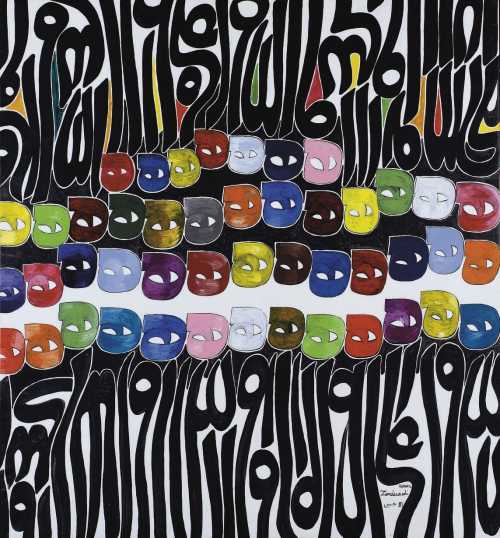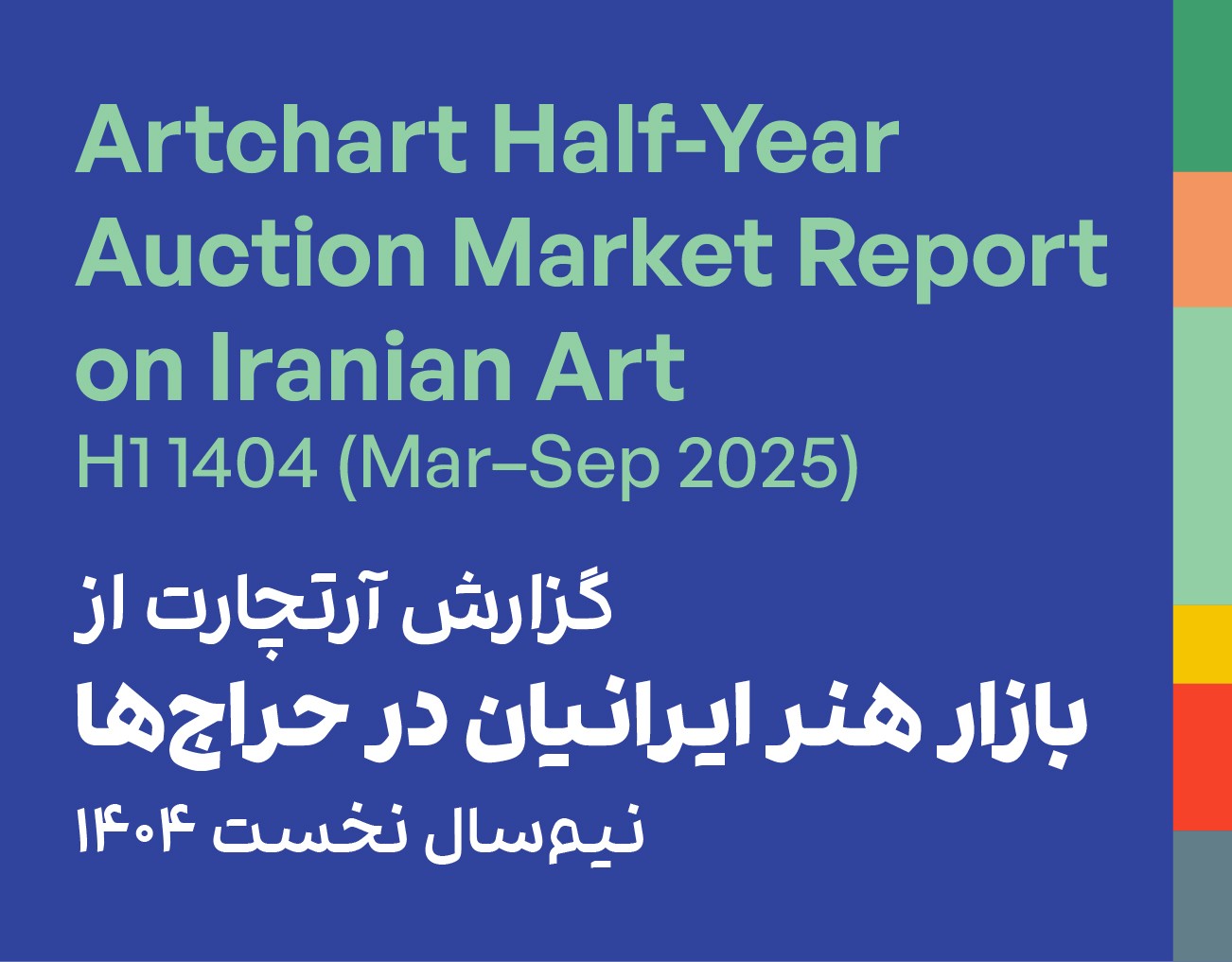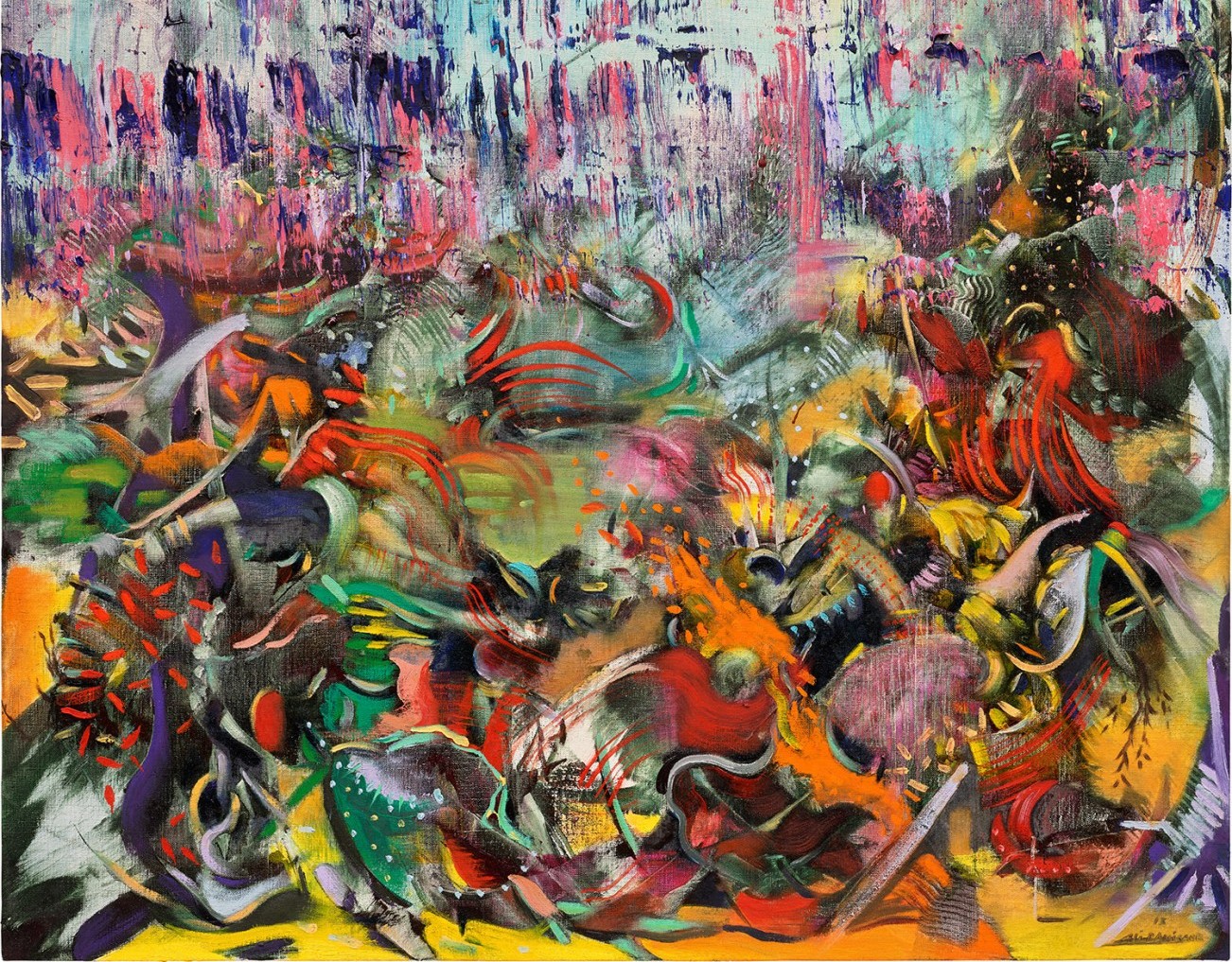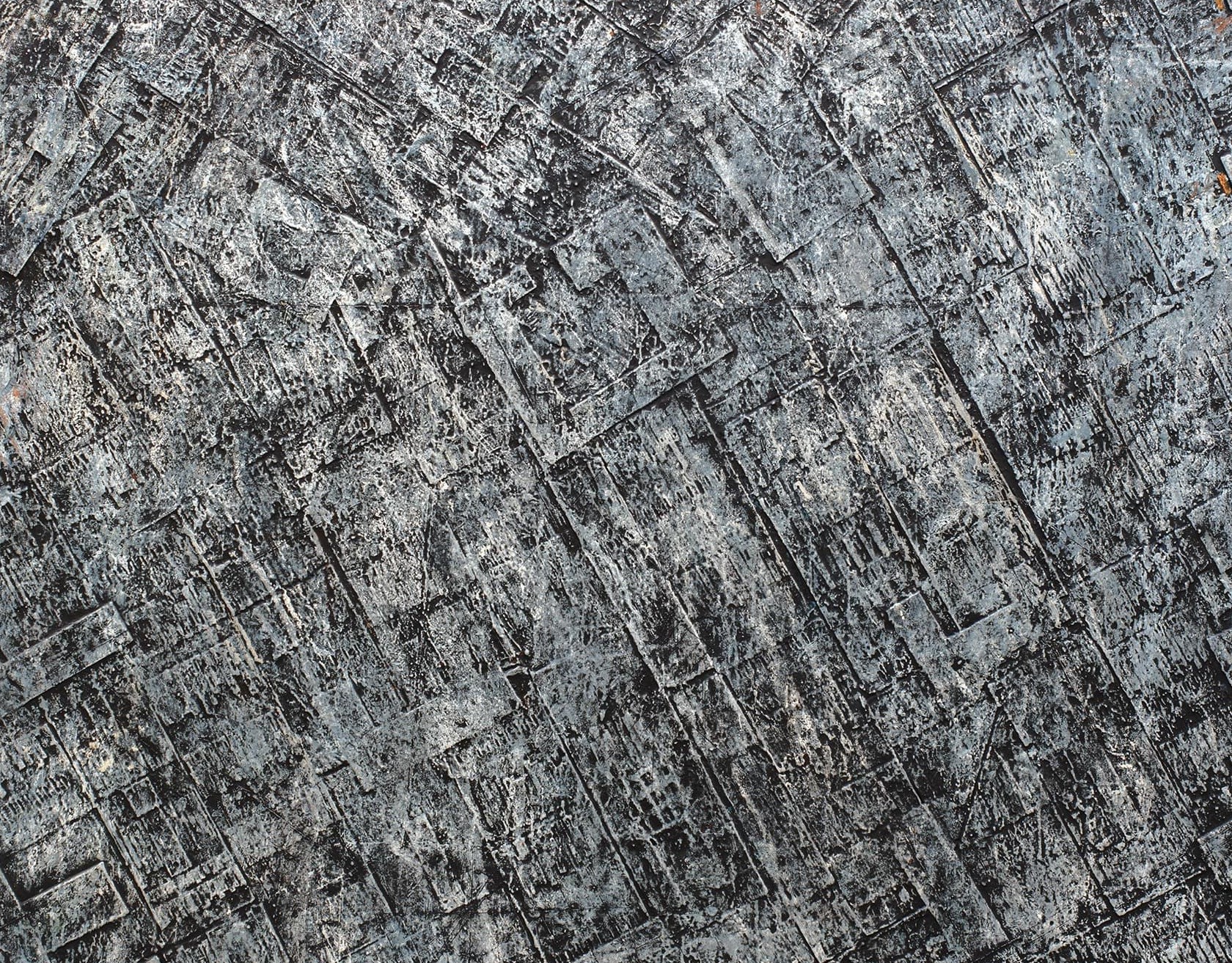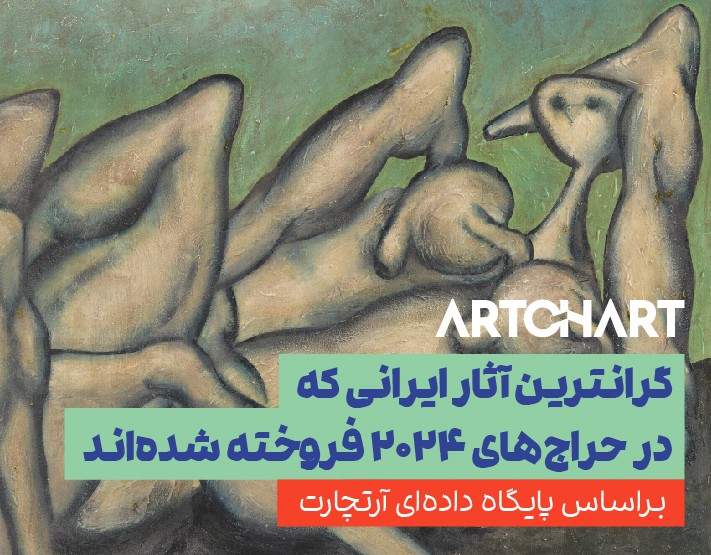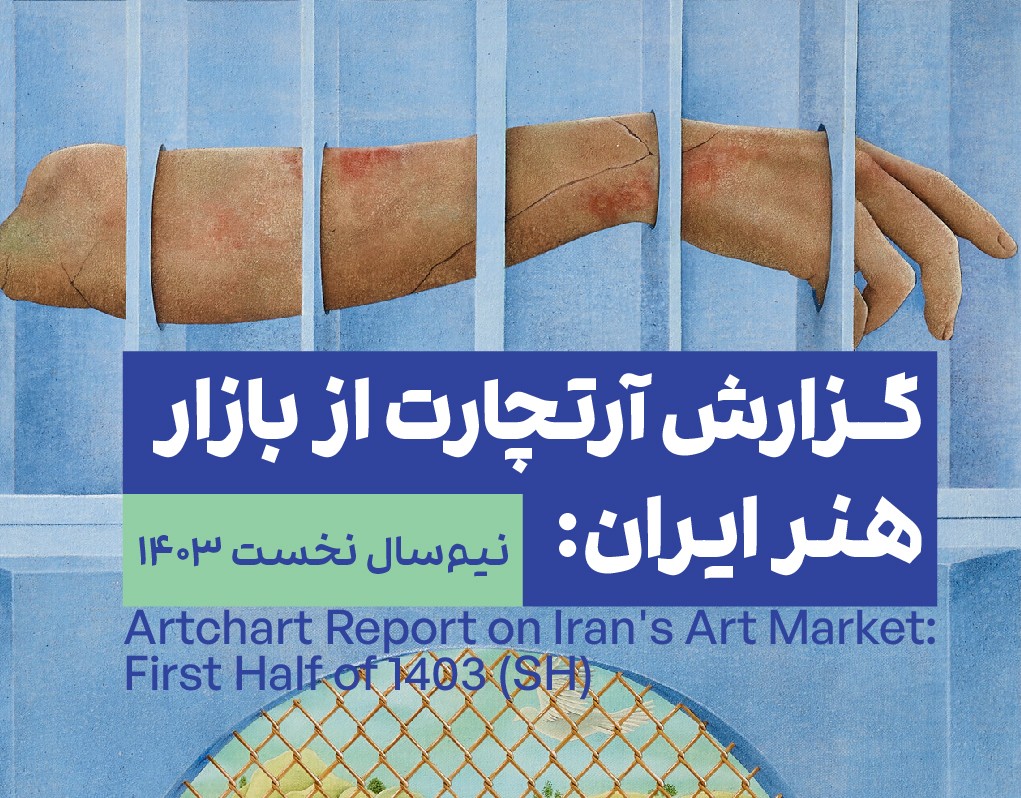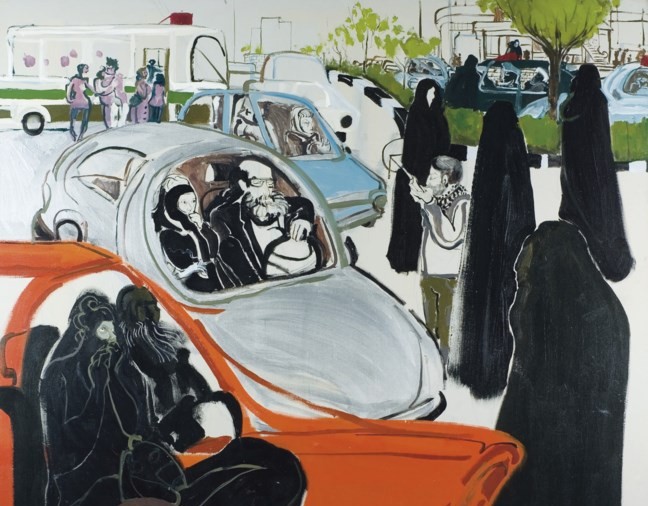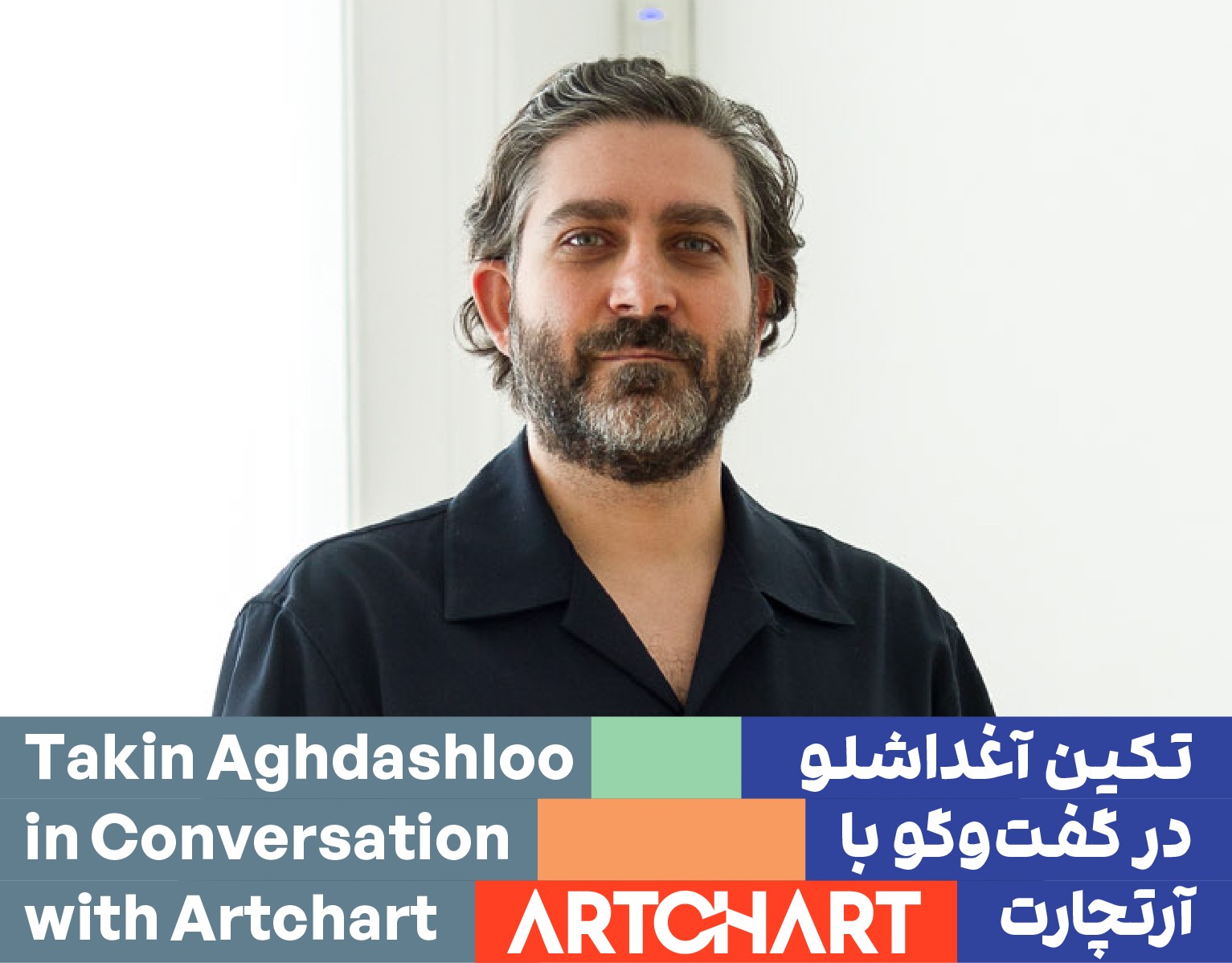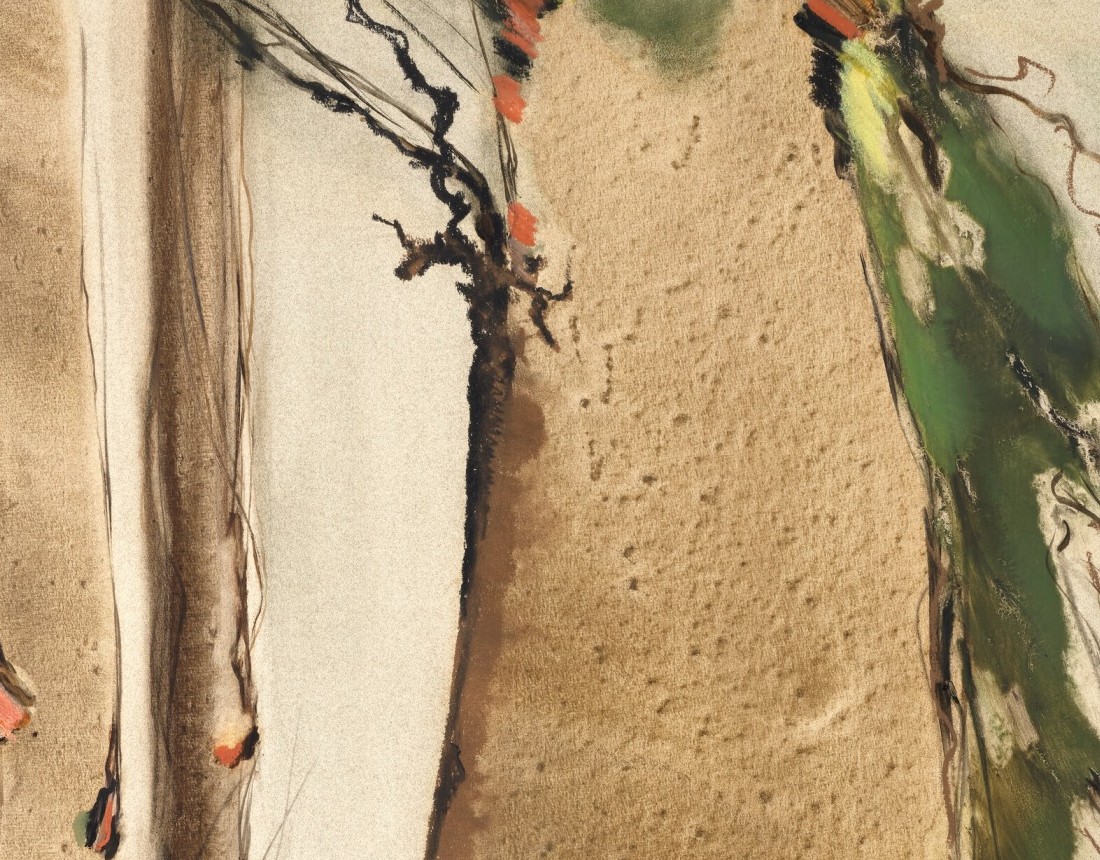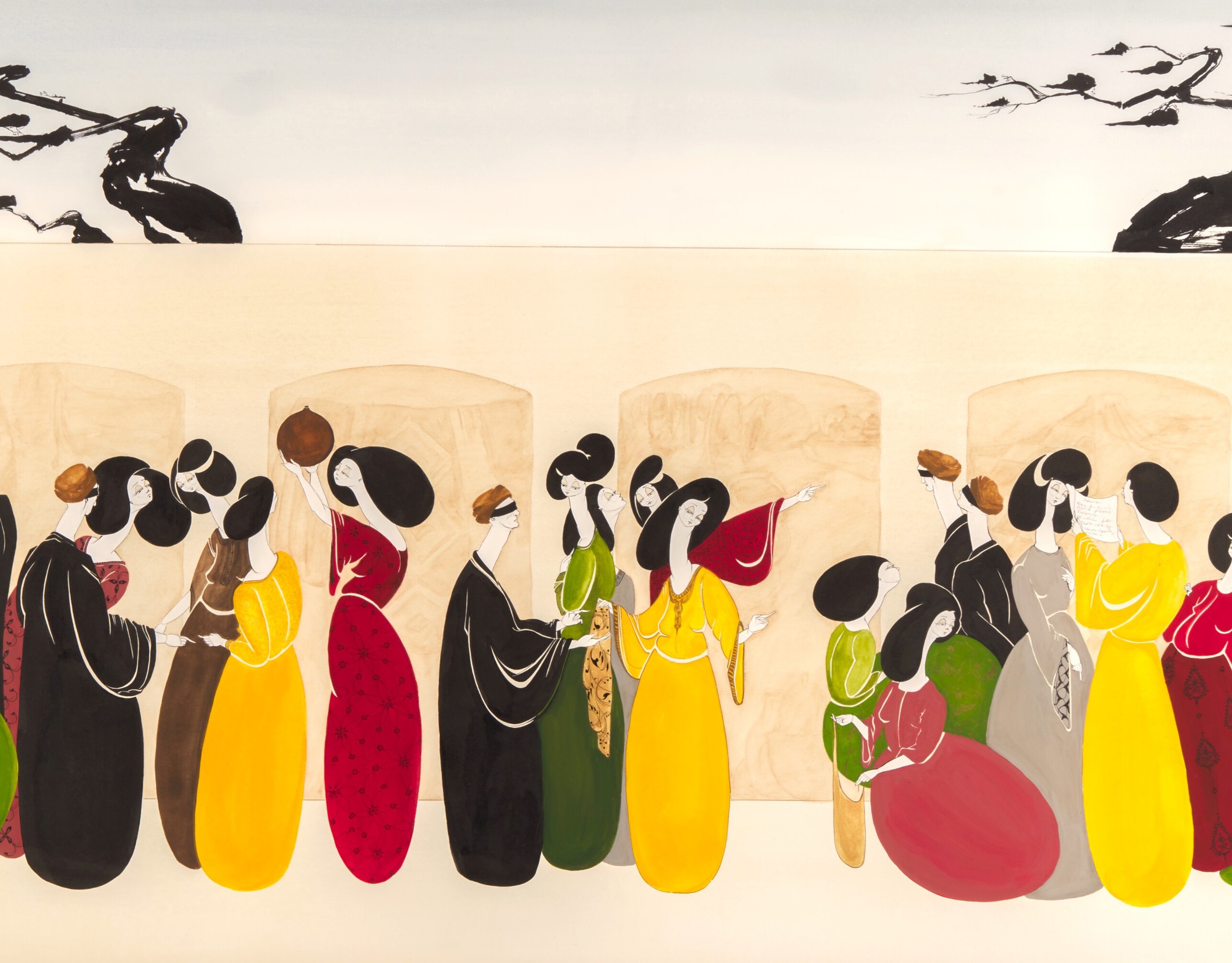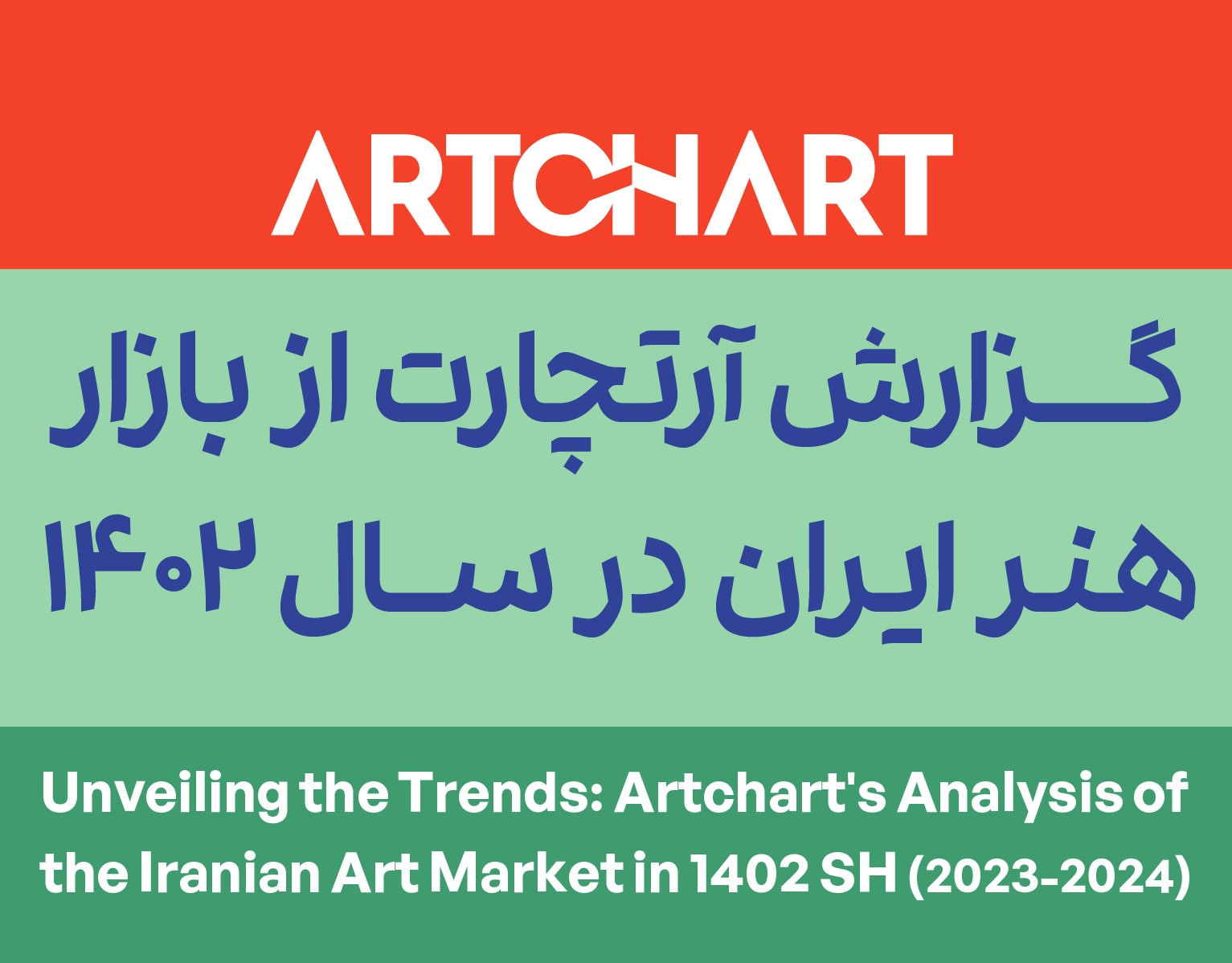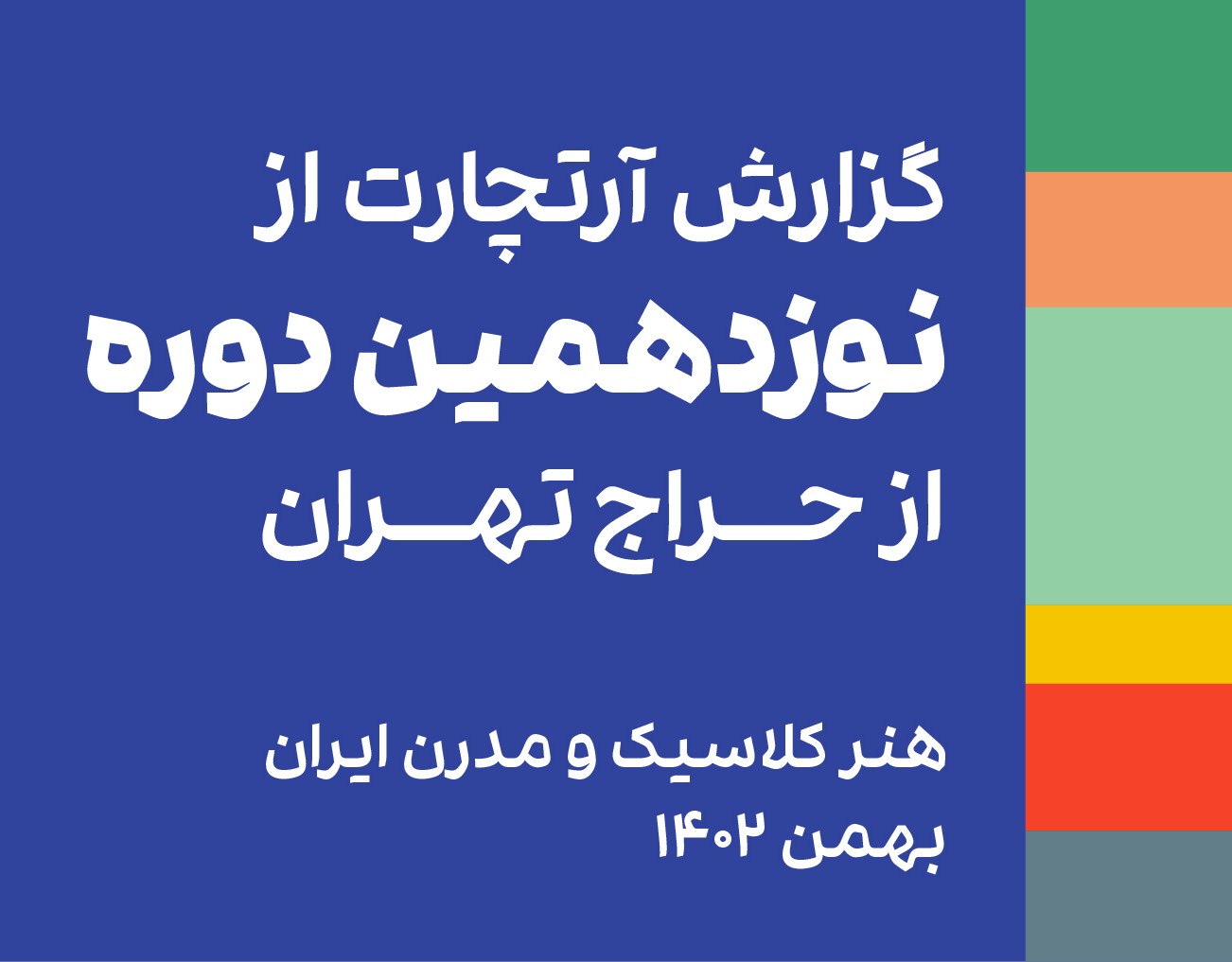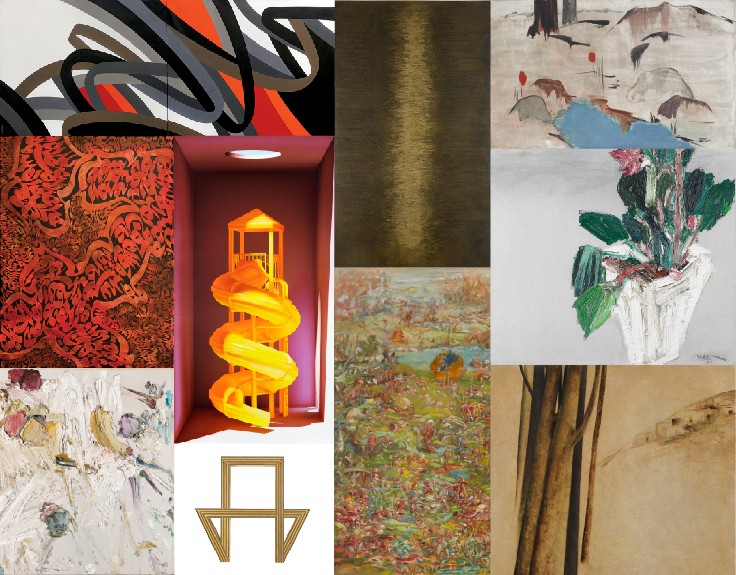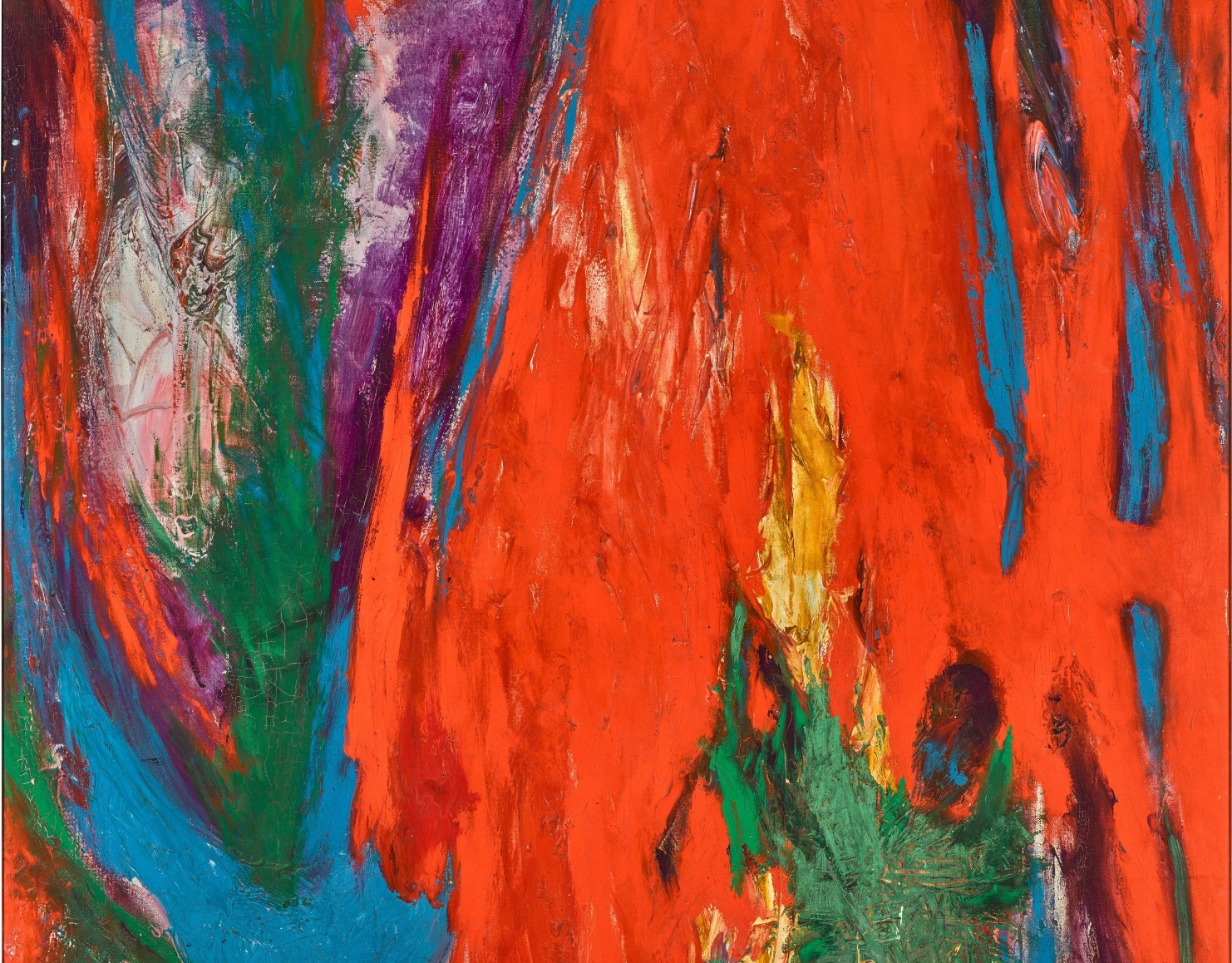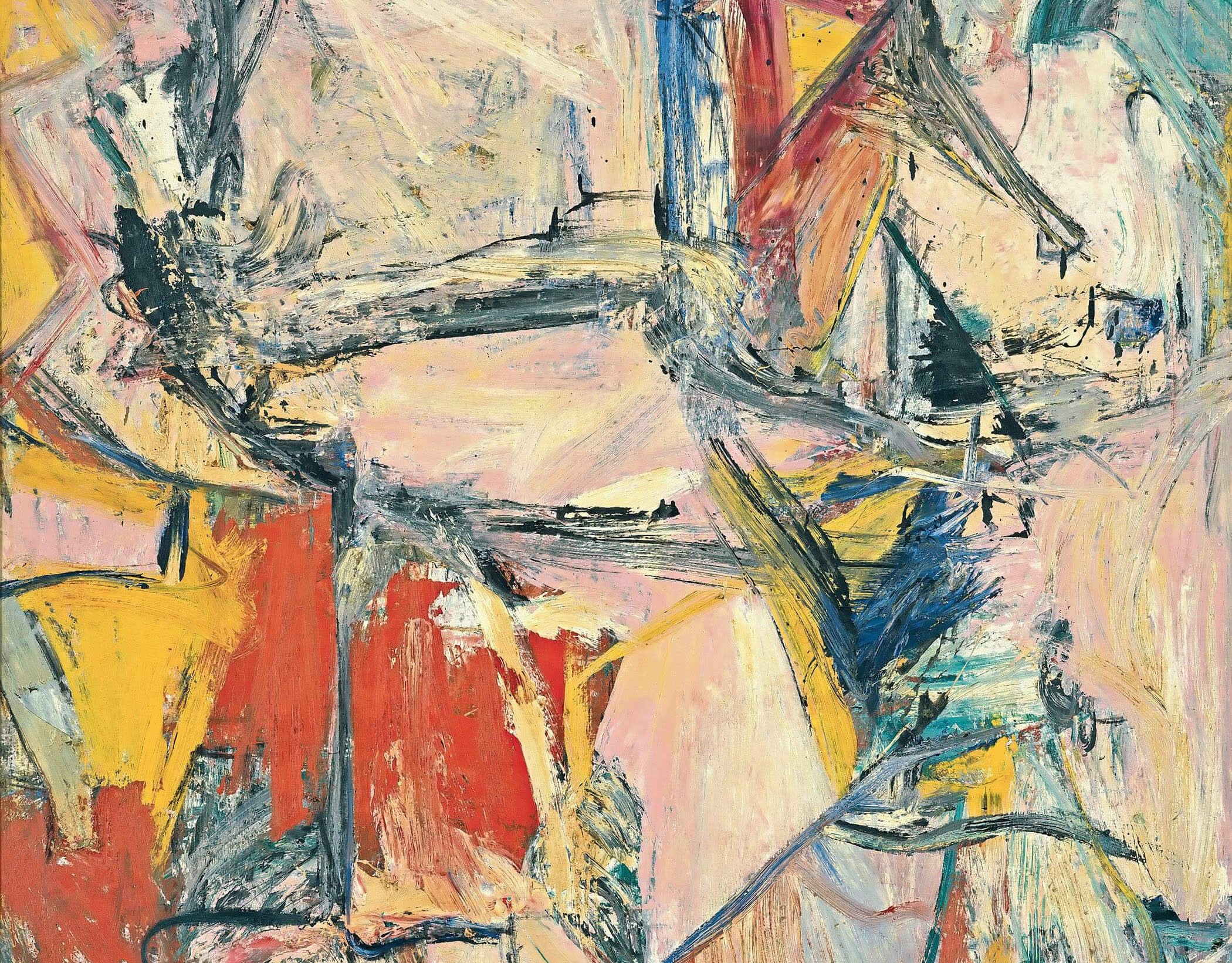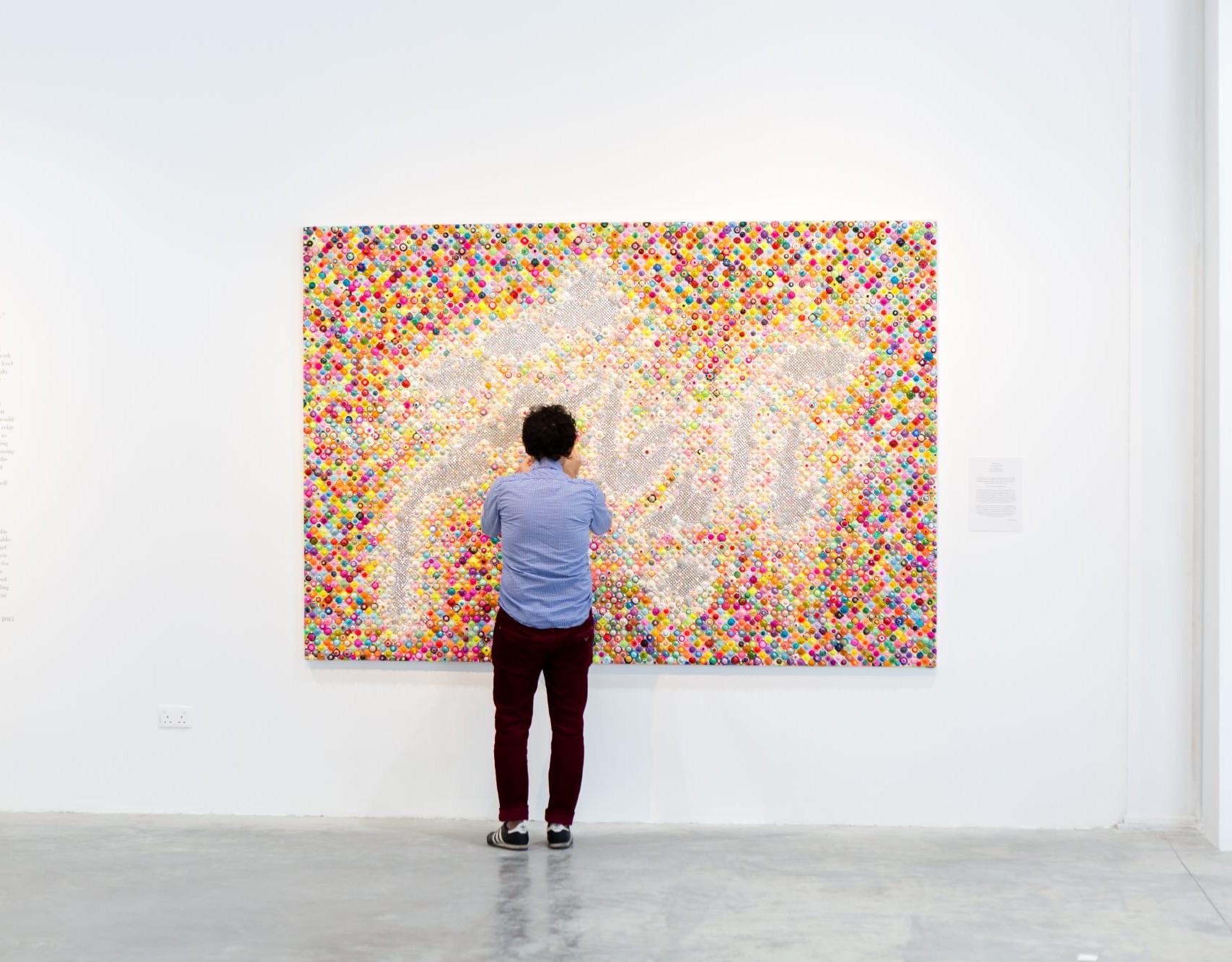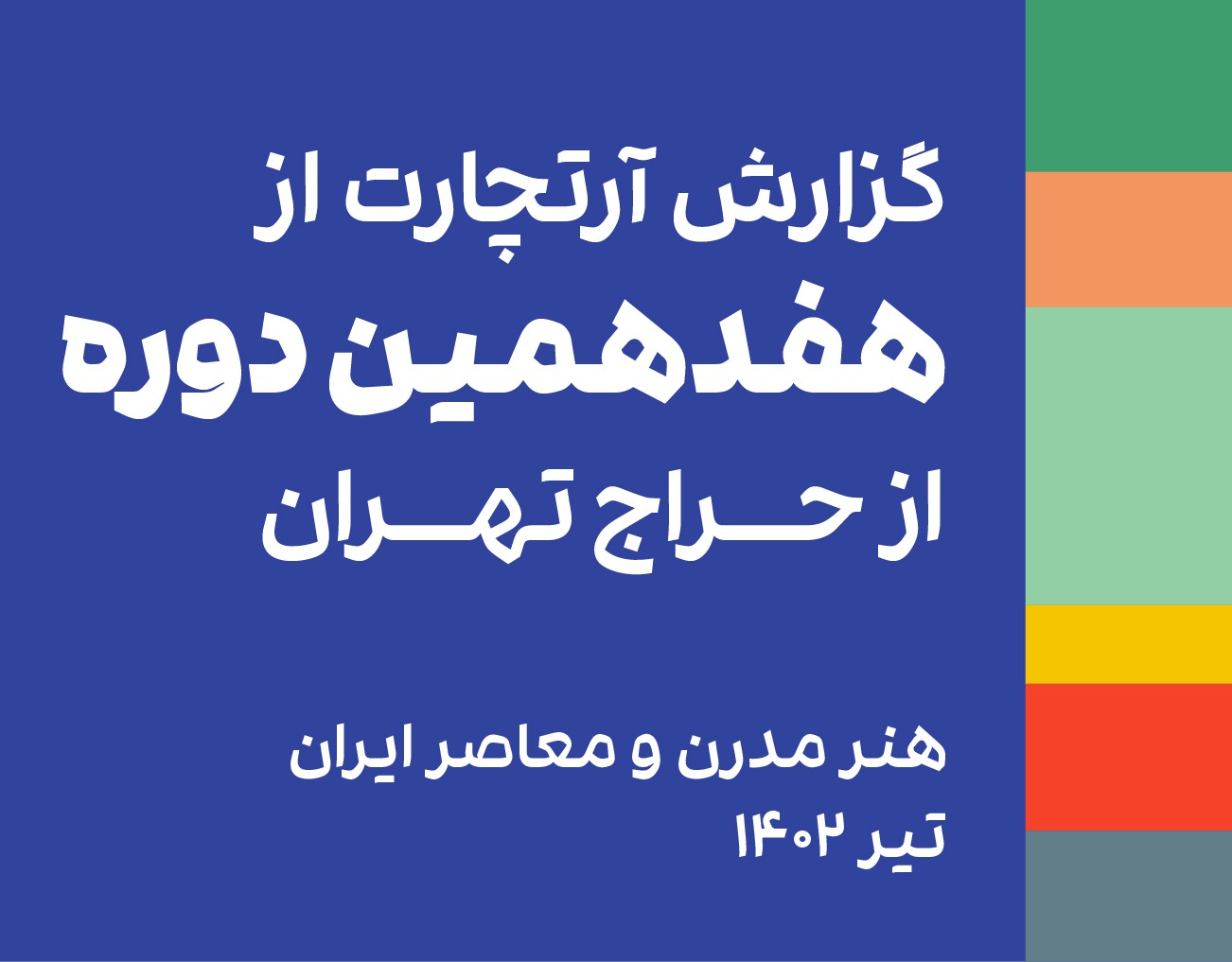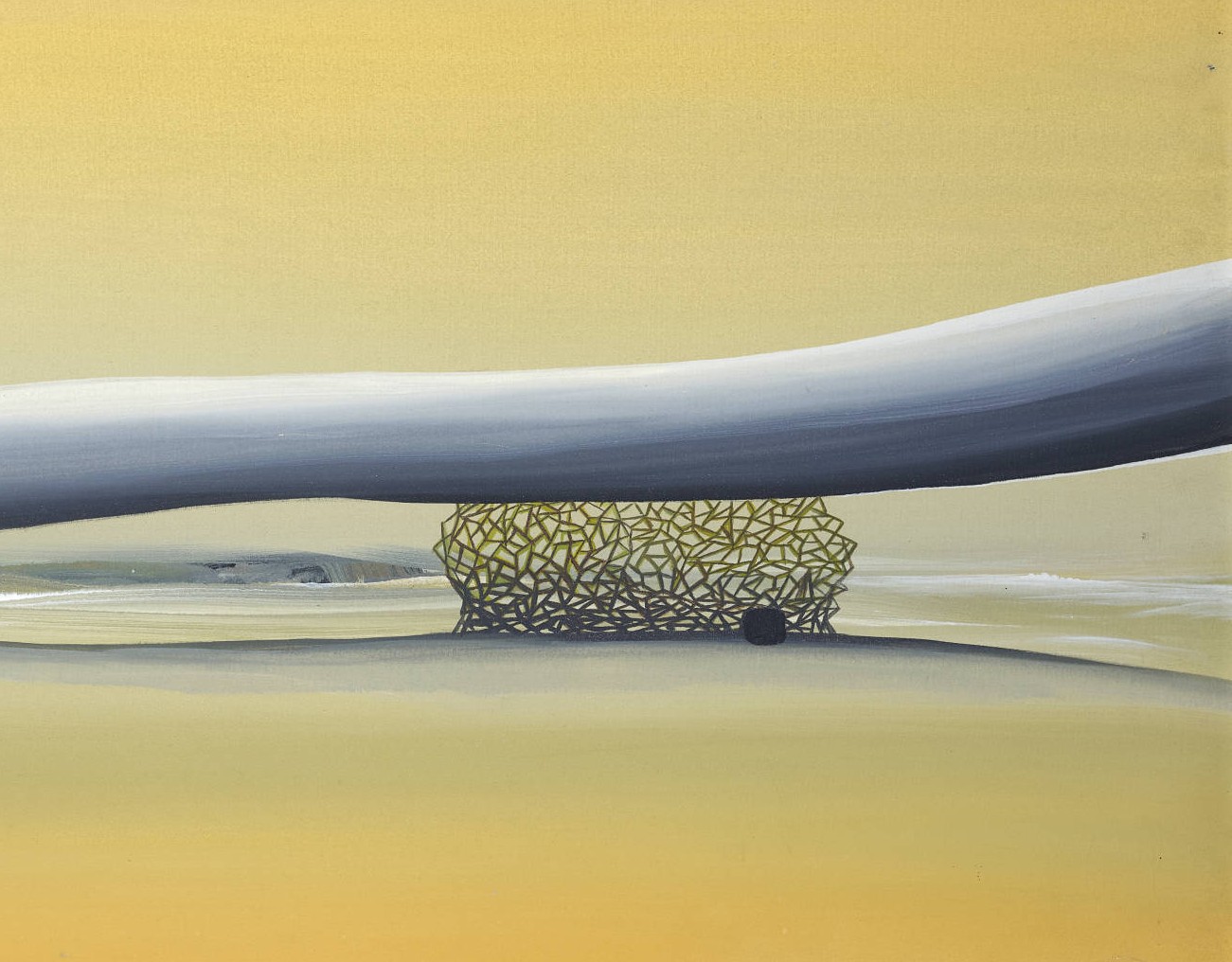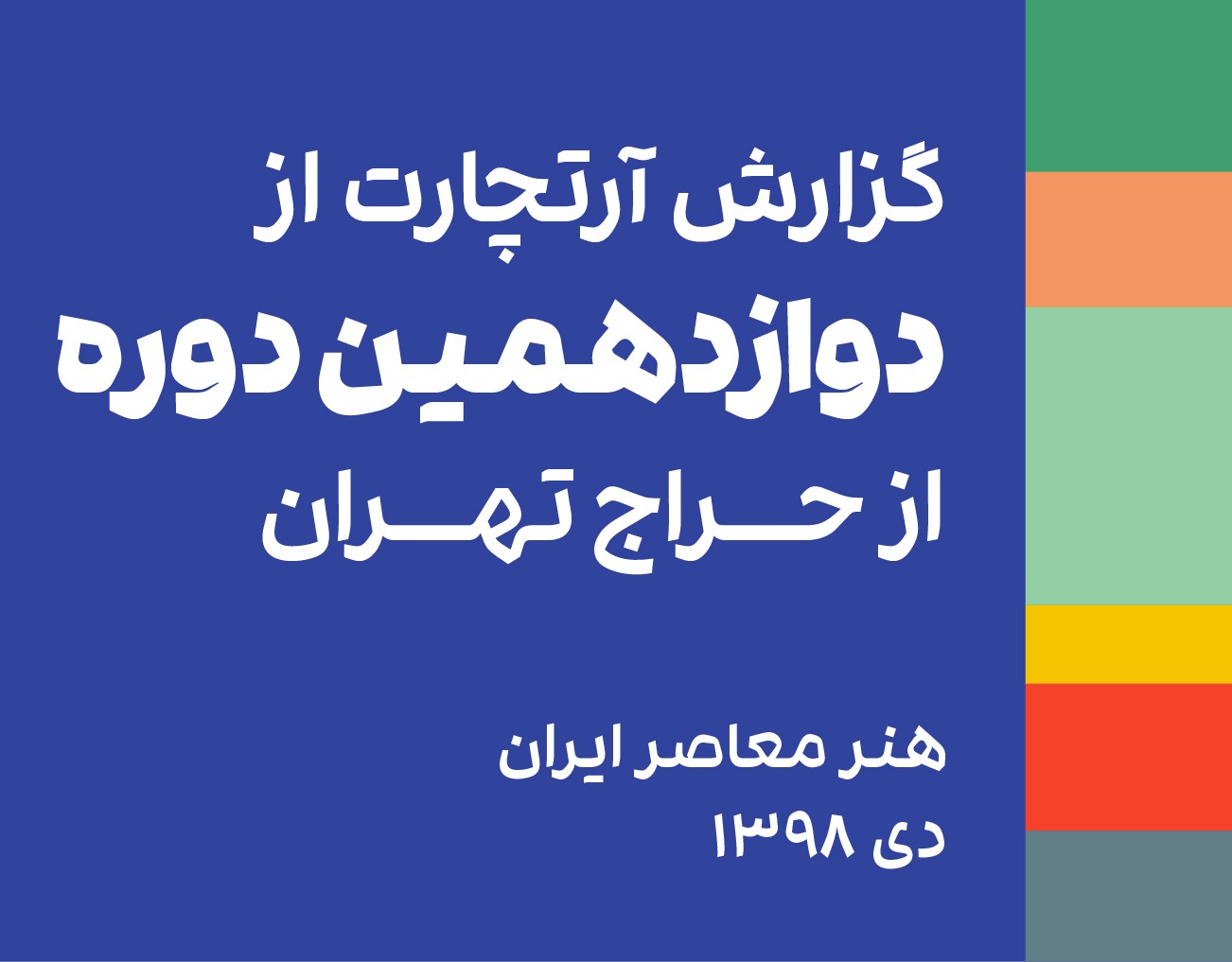About Hossein Zenderoudi
Charles-Hossein Zenderoudi, one of the most renowned Iranian calligrapher-painters and a founding figure of the Saqqa-khaneh Movement, was born in 1937. He received his Fine Arts diploma from the Tehran Academy in 1958 and continued his education at the School of Decorative Arts. However, he left the school in 1961 and moved to France to participate in the second Paris Biennial. His debut solo exhibition was held at the Reza Abbasi Hall. In 2001, the Tehran Museum of Contemporary Art hosted a retrospective exhibition of his works.
Zenderoudi's early artistic endeavors were characterized by surrealism. Following these efforts, he paid special attention to visual symbols from popular and religious culture, creating works that became known as "Saqqa-khaneh." In Europe, he became acquainted with the Lettrism movement and began experimenting with calligraphy through the repetition of letters and words in monochromatic and colorful compositions. In another period, he filled the surfaces of his works with an abundance of small numbers and words, blurring the lines between calligraphy and painting. Zenderoudi has also produced works using handprint techniques during various phases of his career.
The esteemed French critic Pierre Restany wrote about Zenderoudi's work: "Zenderoudi's flexibility in conveying his message has allowed him to create a cultural niche for himself throughout different periods of his career, always maintaining his originality and modernity in a unique way. After Saqqa-khaneh, he embraced Parisian Informel and Lettrism, prioritizing calligraphic symbols over traditional methods, thereby transforming these symbols to enhance their utility."
Zenderoudi's early artistic endeavors were characterized by surrealism. Following these efforts, he paid special attention to visual symbols from popular and religious culture, creating works that became known as "Saqqa-khaneh." In Europe, he became acquainted with the Lettrism movement and began experimenting with calligraphy through the repetition of letters and words in monochromatic and colorful compositions. In another period, he filled the surfaces of his works with an abundance of small numbers and words, blurring the lines between calligraphy and painting. Zenderoudi has also produced works using handprint techniques during various phases of his career.
The esteemed French critic Pierre Restany wrote about Zenderoudi's work: "Zenderoudi's flexibility in conveying his message has allowed him to create a cultural niche for himself throughout different periods of his career, always maintaining his originality and modernity in a unique way. After Saqqa-khaneh, he embraced Parisian Informel and Lettrism, prioritizing calligraphic symbols over traditional methods, thereby transforming these symbols to enhance their utility."
The Most Expensive Artwork
At Auctions
First Attendance
24 May 2006
# Attendance
239
# Artworks
403
Average Realized Price
100,337 USD
Average Min Estimate
60,720 USD
Average Max Estimate
84,601 USD
Sell-through Rate
67.25%
Average Growth of Artwork Worth
63.951%
Timeline
Art Contemporain auction
4 December
Post-War & Contemporary Art auction
4 December
Modern & Contemporary Middle Eastern Art auction
25 November
Post-war & Contemporary Art auction
19 November
Contemporary Art I auction
19 November
Modern & Contemporary Middle East auction
28 October
Art of Living & Prestige auction
25 September
Charsoo exhibition
5 September
Modern & Contemporary Art auction
2 July
Prints, Works on Paper, Topographies... auction
23 June
Contemporary Art auction
27 May
The 23rd Tehran - Modern and Contemporary Iranian Art auction
22 May
Modern and Contemporary Middle Eastern Art Online auction
8 May
Modern and Contemporary Middle East auction
1 May
For Nowruz exhibition
14 March
Contemporary Discoveries Including the Marcel Lehmann Lefranc Collection auction
20 February
Middle East / 20th Century Art auction
19 December
Winter Sale - Part 1 - Paintings and Sculptures auction
11 December
20th/21st Century Art auction
10 December
Timeless Creation exhibition
25 October
Modern & Contemporary African and Middle Eastern Art auction
26 September
Saqqakhaneh, the Birth of a Dream exhibition
13 September
Gargas exhibition
23 August
Resize exhibition
16 August
The 20th Tehran- Modern and Contemporary Iranian Art auction
5 July
Art Contemporain auction
7 June
Modern and Contemporary Middle Eastern Art auction
5 June
Modern and Contemporary Art Dubai auction
31 May
Nine Works of Iranian Modern Art exhibition
29 May
Prints, illustrated books and multiples I auction
17 May
A Collection exhibition
10 May
Art Contemporain Vente Online auction
30 April
Duplex Beirut – Paris Middle-East Modern & Contemporary auction
25 April
April 2024 Estates Sale auction
7 April
Artibition Auction - March 2024 auction
11 March
10s of Artworks, 10s of Millions exhibition
8 March
The 19th Tehran -Classic and Modern Iranian Art auction
24 January
Modern and Contemporary Art Day auction
7 December
Art Contemporain auction
6 December
Modern and Contemporary Middle Eastern Art auction
15 November
20th Century Art/Middle East auction
24 October
Collector - Modern exhibition
29 September
Annual Amordad 1402 exhibition
4 August
The 17th Tehran Modern and Contemporary Iranian Art auction
18 July
20th and 21st Century Fine Art auction
13 June
Root exhibition
9 June
Art Contemporain Evening auction
5 June
Modern and Contemporary Middle Eastern Art auction
24 May
Contemporary Art auction
4 May
resize exhibition
13 April
Modern and Contemporary Art auction
31 January
Art Contemporain Evening auction
6 December
Contemporary Art auction
1 December
Modern and Contemporary Middle Eastern Art Including Baghdadiyat - Part III auction
23 November
20th Century Art - Middle East auction
25 October
Fine Art, Furnishings, & Collectibles auction
28 September
Selected 6 exhibition
16 September
Modern Painting and Decorative Arts of the 20th Century auction
14 September
Printedize exhibition
9 September
Post-War and Contemporary Art, Day Sale auction
29 June
POST WAR & CONTEMPORARY ART auction
27 June
Sale No. 75 auction
22 June
Post War and Contemporary Art auction
9 June
Art Contemporain Evening auction
8 June
A Wall A Piece exhibition
20 May
Resize exhibition
13 May
April Day 2: Important Works of Art auction
28 April
LITHOGRAPHS, ETCHINGS, POSTERS & DRAWINGS auction
19 April
20th Century Art / Middle East auction
23 March
POSTERS, LITHOGRAPHS, WORKS ON PAPER, PAINTINGS auction
22 March
Post-War and Contemporary Art auction
14 March
Vente POST WAR & ART CONTEMPORAIN auction
14 March
Nowruz Festival of Rivers exhibition
10 March
A Selection of Modern Works from The Laal Collection exhibition
25 February
Point Of View exhibition
25 February
Soft Edge of the Blade exhibition
10 February
January Day 2, Fine Art and Asian Art auction
27 January
Solo Exhibition Of Hossein Zendehroudi exhibition
21 January
The 15th Tehran- Modern Iranian Art auction
14 January
Posters, Lithographs, Works on paper, Paintings auction
10 January
Sober Weekend exhibition
11 December
ARTE MODERNA E CONTEMPORANEA auction
25 November
Modern and Contemporary Middle Eastern Art including Baghdadiyat Part II auction
17 November
The Mana Jalalian Collection: A Rare Collection of Iranian Modern Art exhibition
15 November
arts+design #5 auction
7 November
20th Century Art / Middle East auction
20 October
No.9 auction
3 September
Posters, Lithographs, Works on paper, Paintings auction
15 July
Art Contemporain Evening Sale auction
3 June
Post-War & Contemporary Art auction
3 June
ARTE MODERNA E CONTEMPORANEA + DESIGN auction
27 May
The Collection of Liam Gallery exhibition
20 May
POSTERS, LITHOGRAPHS, PAPER WORKS auction
23 March
20th Century Art / Middle East auction
23 March
Souvenir exhibition
2 February
Sanctuary exhibition
15 January
The 13th Tehran- Modern and Contemporary Iranian Art auction
15 January
Modern and Contemporary Middle Eastern Art auction
24 November
Middle Eastern, Modern and Contemporary Art auction
11 November
20th Century Art / Middle East auction
20 October
No.6 auction
16 October
Fine Art, Jewelry, Antiques, Midcentury & Asian Estate auction
11 October
SUMMER SALE ONLINE ONLY auction
7 September
Full Length... exhibition
4 September
Virus of collecting exhibition
4 September
Middle Eastern Art Online auction
6 August
One by One exhibition
3 July
No.3 auction
23 April
دوازدهمین دوره حراج تهران auction
17 January
POST-WAR & CONTEMPORARY ART auction
13 December
Editions auction
11 December
MODERN AND CONTEMPORARY ART auction
4 December
ORIENTAL ARTS & ORIENTALISM - PRESTIGE auction
2 December
POST-WAR & CONTEMPORARY ART auction
22 November
International Art auction
8 November
ORIENTAL ART auction
6 November
Modern and Contemporary Middle Eastern Art auction
23 October
Connoisseur's Look exhibition
12 July
یازدهمین دوره حراج تهران auction
5 July
EASTERN ARTS & ORIENTALISM auction
17 June
Art Contemporain - Evening Sale auction
5 June
XXTH, MODERN AND CONTEMPORARY PAINTINGS auction
29 May
Modern and Contemporary Prints auction
15 May
Modern and Contemporary Middle Eastern Art auction
1 May
20th Century Art / Middle East auction
30 April
Middle Eastern Modern & Contemporary Art auction
23 March
2018 Collection Selling exhibition
17 January
دهمین دوره حراج تهران auction
11 January
Abstract and Contemporary Art auction
12 December
MODERN AND CONTEMPORARY ART - SECOND SESSION auction
4 December
20TH CENTURY PRINTS & LITHOGRAPHS auction
22 November
Modern and Contemporary Middle Eastern Art auction
24 October
Middle Eastern, Modern and Contemporary Art auction
24 October
20th Century Art / Middle East auction
23 October
OLD BACKDROP OF THE STADLER GALLERY, PARIS - PHOTOGRAPHS, PRINTS, SCULPTURES AND MODERN PAINTINGS auction
19 October
The 9th Tehran- Classic and Modern Iranian Art auction
29 June
Drouot Richelieu, Salles 5 & 6, Art Abstrait et Contemporain auction
6 June
Arte Moderna e contemporanea auction
17 April
Artnet Online - Berlin - March 2018 auction
28 March
Dubai: Post War and Contemporary Art auction
22 March
+۹۶ exhibition
16 February
هشتمین دوره حراج تهران auction
12 January
32 Viewpoint exhibition
8 December
Hôtel Drouot, Salles 5 et 6, Art Moderne et Contemporain du Moyen-Orient* auction
6 December
Modern and Contemporary Middle Eastern Art Online Sale auction
29 November
Modern and Contemporary Middle Eastern Art auction
28 November
Fall Weekend - Day 3 auction
19 November
Boundless: Dubai auction
13 November
Middle Eastern, Modern and Contemporary Art auction
25 October
20th Century Art / Middle East auction
23 October
Contemporary Ink Art: Confluence auction
2 October
BOOKS AND ALBUMS, GEOGRAPHIC MAPS, OLD AND MODERN PRINTS auction
22 September
Modern and Contemporary Art: Icons and Rising Stars of the Middle East auction
19 September
هفتمین دوره حراج تهران auction
7 July
Drouot Richelieu, Salle 5, Art Abstrait et Contemporain auction
9 June
Post-War & Contemporary Afternoon Sale auction
18 May
Modern and Contemporary Middle Eastern Art auction
26 April
20th Century Art/ Middle East auction
25 April
Modern & Contemporary Art auction
18 March
The 6th Tehran- Contemporary Iranian Art auction
23 December
Drouot Richelieu, Salle 5 & 6, Art Abstrait & Contemporain* auction
9 December
Art Contemporain Vente du Jour auction
8 December
Drouot Richelieu, Salle 10, Post-War & Art Contemporain* auction
25 November
Post-War & Contemporary Art Afternoon Sale auction
16 November
20th Century Art: Middle East auction
20 October
Modern & Contemporary Art auction
18 October
The Art of Lebanon Part II and Modern and Contemporary Middle Eastern Art auction
12 October
Drouot Richelieu, Salles 5 & 6, Art Abstrait & Contemporain - Peintres Etrangers de la scène Parisienne* auction
15 June
Art Contemporain Vente du Jour auction
10 June
پنجمین دوره حراج تهران auction
27 May
Orientalisme auction
18 May
Post War & Contemporary Art Afternoon Session auction
11 May
The Art of Lebanon and Modern and Contemporary Middle Eastern Art auction
27 April
Alchemy: Objects of Desire auction
21 April
Dubai: Modern and Contemporary Art Now and Then auction
16 March
Modern & Contemporary Art auction
16 March
Artworks of the Postwar Era auction
4 February
Art Contemporain auction
9 December
China Now! and Asian Contemporary Art auction
4 December
Art Abstrait et Contemporain auction
4 December
Drouot Richelieu, Salle 2, Tableaux, Mobilier et Objets d'Art auction
20 November
Contemporary Art Day auction
12 November
Modern & Contemporary Art auction
20 October
Drouot Richelieu, Salle 10, Art Contemporain auction
22 June
Art Contemporain auction
2 June
Contemporary Art / Doha auction
21 April
Modern & Contemporary Arab, Iranian and Turkish Art auction
18 March
ABSTRACT & CONTEMPORARY ART - FOREIGN PAINTERS OF THE PARISIAN SCENE auction
10 December
Art Contemporain auction
3 December
Modern and Contemporary Arab, Iranian and Turkish Art auction
21 October
Contemporary Art auction
13 October
Islamic and Indian Art auction
7 October
Art Contemporain auction
5 June
سومین دوره حراج تهران auction
30 May
Tableaux Abstraits et Contemporains, Sculptures auction
27 April
Islamic and Indian Art auction
8 April
Regard sur le XXe siècle #5 Art contemporain & Design auction
5 April
Modern & Contemporary Arab, Iranian & Turkish Art auction
19 March
Importants Tableaux Abstraits et Contemporains, Sculptures auction
15 December
Schuler Auktionen Geneve auction
13 December
Art Contemporain auction
4 December
Modern and Contemporary Art auction
24 November
Modern and Contemporary Arab,Iranian and Turkish Art Part II auction
30 October
Hôtel Drouot, Salle 7, Art Contemporain auction
12 June
Art Contemporain auction
4 June
دومین دوره حراج تهران auction
28 May
Art Ancien, Moderne et Contemporain auction
18 May
Modern and Contemporary Arab,Iranian and Turkish Art Part II auction
17 April
Modern and Contemporary Arab,Iranian and Turkish Art Part I auction
16 April
Dessins Modernes et Contemporains, Design auction
13 April
Drouot Richelieu, Salle 5 & 6, Tableaux, Dessins et Sculptures des XIXe et XXe siècles auction
19 December
Art Contemporain auction
30 November
Drouot Richelieu, Salles 1 & 7, Art Contemporain auction
14 November
Modern & Contemporary Arab, Iranian and Turkish Art Part II auction
24 October
Nineteen to Now, incl. Topographical Observations auction
4 September
Contemporary Art Day auction
29 June
Art Contemporain, Art Urbain Français auction
22 June
Art Contemporain auction
31 May
اولین دوره حراج تهران auction
22 May
Modern and Contemporary Arab, Iranian and Turkish Art Part I auction
17 April
Drouot Richelieu, Salle 10, Abstraction - Tableaux Modernes et Contemporains auction
21 November
Visions d'Orient - De l'orientalisme à l'art contemporain auction
4 November
Modern and Contemporary Arab, Iranian and Turkish Art Part II auction
26 October
Modern and Contemporary Arab, Iranian and Turkish Art Part I auction
25 October
Contemporary Art / Arab & Iranian auction
4 October
Tableaux, Sculptures des XIXe et XXe siècles auction
22 August
Modern and Contemporary Arab, Iranian and Turkish Art auction
19 April
Arte Moderna e Contemporanea e Fotografia auction
12 April
Vente Art Contemporain auction
22 March
Contemporary Art Day auction
16 February
Hurouf: The Art of the Word auction
16 December
Drouot Richelieu, Salle 7, Vente Tableaux Modernes auction
19 November
Modern and Contemporary Art auction
26 October
International Modern and Contemporary Art auction
26 October
Art Contemporain auction
24 October
Contemporary Art / Arab & Iranian auction
20 October
Modern & Contemporary Middle Eastern & South Asian Art auction
11 October
Art Abstrait et Contemporain auction
5 July
Contemporary Art Day auction
29 June
Art Contemporain 2 auction
1 June
International Modern & Contemporary Art, Including Masterpieces from The Collection of Dr. Mohammed Said Farsi auction
27 April
Drouot Richelieu, Salle 4, Estampes, Dessins, Tableaux Modernes auction
31 March
International Modern & Contemporary Art auction
27 October
Art Moderne et Contemporain Iranien et Arabe auction
24 October
Modern & Contemporary Middle Eastern & South Asian Art auction
12 October
Tableaux Orientalistes et Art Moderne Arabe et Iranien auction
16 June
International Modern & Contemporary Art auction
29 April
Contemporary Art auction
18 March
Impressionnisme, Art Ancien, Moderne et Contemporain auction
14 March
INTERNATIONAL ART ORIENTALIST PAINTING auction
20 December
Tableaux Orientalistes et Art Moderne Arabe et Iranien auction
17 December
Modern & Contemporary Arab, Iranian, Indian & Pakistani Art auction
24 November
International Modern and Contemporary Art auction
30 October
Modern and Contemporary Arab and Iranian Art auction
23 October
Post-War & Contemporary Art Evening Sale auction
19 October
Contemporary Art Day Sale auction
18 October
Tableaux Orientalistes et Art Moderne Arabe et Iranien auction
3 June
Arte Moderna e Contemporanea auction
22 May
International Modern and Contemporary Art auction
30 April
Modern & Contemporary Arab, Iranian, Indian & Pakistani Art auction
3 March
Arte Moderna e Contemporanea auction
11 December
International Modern & Contemporary Art auction
31 October
Modern & Contemporary Arab & Iranian Art auction
24 October
MODERN AND CONTEMPORARY ART auction
1 February
S. V. V., Drouot Richelieu, Salles 1 et 7 auction
13 June
International Modern & Contemporary Art at the Jumeirah Emirates Towers Hotel, Dubai auction
24 May
Articles
Artchart Half-Year Auction Market Report on Iranian Art - H1 1404 (Mar–Sep 2025) 8 December 2025
Artchart Half-Year Auction Market Report on Iranian Art - H1 1404 SH (Mar–Sep 2025) provides a detailed overview of the key trends and developments observed in this six-month period of the Iranian calendar year. The report examines the presence and performance of Iranian artworks in auctions held worldwide during this timeframe, including the activities of major auction houses, the...
Iranian Art in the Secondary Market: Spring 2025 Report 23 July 2025
The Iranian art scene in the first quarter of 1404 SH (March to June 2025) witnessed a diverse range of artistic and commercial events. The Tehran Auction, held on May 22, focused on modern and contemporary Iranian art, offering 100 works by 97 Iranian artists. Galleries inside the country showcased exhibitions of modern and contemporary masters alongside younger artists, while inte...
Modern and Contemporary Middle Eastern Art Auctions in Spring 2025: From Tehran to London 28 May 2025
In Spring 2025, three dedicated auctions focusing on Modern and Contemporary Middle Eastern art were held alongside the 23rd edition of the Tehran Auction. Altogether, these events generated a total sales volume of approximately $9.6 million. Among the Middle Eastern sales, Lebanese artists led the charts, while the Tehran Auction alone accounted for nearly $2.2 million in sales of...
The Most Expensive Iranian Artworks Sold in 2024 Auctions 24 December 2024
This article presents an overview of the ten highest-priced Iranian artworks sold at auction in 2024. The featured works are by six renowned artists: Ali Banisadr, Sohrab Sepehri, Bahman Mohasses, Mehdi Qadyanloo, Hossein Zenderoudi, and Aydin Aghdashloo. All of these artworks are paintings and were sold exclusively through three prestigious auction houses—Christie's, Sotheby's, and...
Artchart Report on Iran's Art Market: First Half of 1403 (SH) 29 October 2024
Artchart, a data discovery and analysis platform focused on Iran’s art market, has been documenting and analyzing economic data for this sector since its founding in 1398 SH, offering essential insights to Iranian professionals and audiences. Since 1401 SH, Artchart has issued annual reports on Iran’s art market. This release marks its first semi-annual report, providing a mid-year...
Iranian Art of the 1990s and 2000s: Trends, Movements, and Market (Part Two) 24 July 2024
The 2000s and 2010s are considered pivotal decades in the landscape of Iranian art. During this period, new artistic approaches were introduced into the Iranian visual arts scene by both the public and private sectors. The art market also began to take an interest in Middle Eastern art, organizing the first auctions dedicated to these works. In the early auctions specifically focuse...
Takin Aghdashloo Discusses Why Galleries Prefer London in Exclusive Artchart Interview 18 June 2024
Takin Aghdashloo, the curator of the exhibition "Nine Works from Iranian Modern Art,” elaborated on the details of this exhibition and curatorship matters in a conversation with Artchart. The exhibition took place from the 9th to the 13th of Khordad (May 29th to June 2nd) at the temporary space of Bavan Gallery in Cromwell Place, London. Featuring works by nine artists including Ayd...
A Review of Christie's Modern and Contemporary Dubai Online Auction, Spring 2024 2 June 2024
The Modern and Contemporary Dubai online auction was held on Christie's website from May 9 to May 31, 2024. In this auction, works by 70 artists were featured, totaling 90 artworks. Out of these, 75 pieces were sold, resulting in a total sale of $2.2 million. Fourteen Iranian artists also had their works presented in this auction, achieving a 100% sales rate. The most expensive piec...
A Review of Sotheby's and Millon's Modern and Contemporary Middle Eastern Art Auctions in Spring 2024 1 May 2024
As we step into the spring of 2024, the Middle Eastern art auction season is in full bloom, maintaining its biannual rhythm with showcases in both autumn and spring. Two events of particular note occurred on April 25th, 2024, hosted by both Sotheby's & Millon. This marked the commencement of the year's inaugural Middle Eastern art auction, promising a captivating exploration of...
Iranian Art Market Report for 1402 SH (2023-2024) 20 April 2024
Artchart, which had previously examined the Iranian Art Market in 1401 SH (2022-2023), has once again provided an in-depth report for 1402 SH (2023-2024). The forthcoming report will analyze the data collected in 1402 SH and compare it to previous years to illustrate the current state and trends within the Iranian art market. The initial section provides an overview of the mos...
The 19th Tehran Auction Report 10 February 2024
The 19th Tehran auction, also known as the 5th Classic and Modern Iranian Art auction, took place on January 26, 2024, at Parsian Azadi Hotel, Tehran. With a focus on both modern and classic styles, this auction featured 89 works by 69 artists, resulting in the successful sale of 82 pieces. Remarkably, the auction achieved an impressive sales rate, with 92% of the presented works fi...
The most expensive Iranian works sold in 2023 27 December 2023
With the end of 2023, the Artchart team decided to introduce 10 expensive works of Iranian artists that have been sold at auctions. These works are selected and arranged based on Atchart database and dollar rate. In this short essay, you will read about these works and the successful artists of 2023.
A Report of Sotheby's Middle East Auction, October 2023 28 October 2023
This fall, Sotheby’s is showcasing several important private collections at the heart of its bi-annual 20th Century Art/Middle East sale. From pioneering modernist masters to groundbreaking contemporary artists, one of the binding principles guiding these female-led collections are passion, dedication and the connections and conversations incited by powerful works. It is rare to be...
Abstract art in the art market 4 September 2023
Abstract painting is one of art trends in 2023 and has experienced growing in value in the art market in last few years. According to Artsy's 2023 survey, 44% of respondents cited "abstract art" as the most important genre of contemporary art in their business.
Market of Iranian Neo-calligraphers 15 August 2023
Neo-calligraphic style entered the modern Iranian art movement in 1964 with the efforts of the pioneers of the Saqakhaneh movement, namely Hossein Zenderoodi, Parviz Tanavoli and Faramarz Pilaram. From this movement, later, a trend called Calligraphy-Painting branched out, which, to some extent, adhered to the rules and style of traditional calligraphy. Since the the 2000s, with the...
۱7th Tehran Auction Sales Report 26 July 2023
The 17th Tehran auction: modern and contemporary, was held on Friday July 21st, 2023 at Parsian Azadi Hotel. This auction achieved a total sale of 214 billion tomans equivalent to 4.3 million dollars, which was a growth of 77.8% compared to the previous period. Artchart has observed the 17th Tehran auction in the upcoming report.
From the Sepehri's trees to the painting's of Pooya Aryanpour; An overview of the Modern and Contemporary Middle Eastern auctions at Bonhames and Millon 29 May 2023
The modern and contemporary art auction was held on May 24, 2023 in Bonames and Millon & Associes auction houses. Iranian artists such as Sohrab Sepehri, Manouchehr Yektaei, Parviz Tanavoli and Marco Grigorian to younger ones such as Pooya Aryanpour were participated in these auctions and some of them were among the most expensive one's that were sold. This report is an overview...
12th Tehran auction: A Report 28 January 2020
The 12th Tehran auction was able to achieve a 22% growth rate in the field of art transactions by selling 97% of the offered works and reaching 31 billion and 717 million Tomans. .
